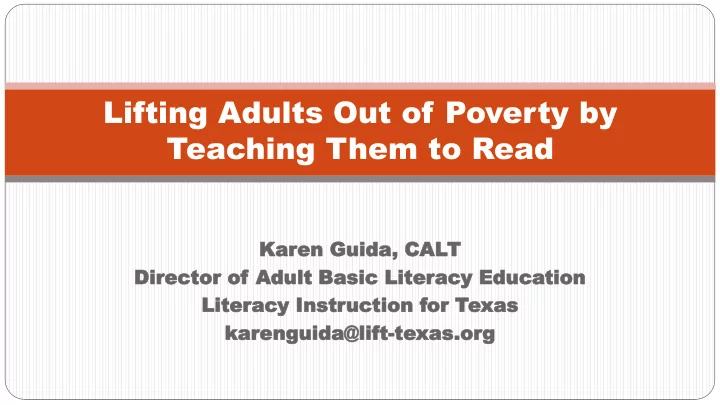

Lifting Adults Out of Poverty by Teaching Them to Read Karen Kar en Guida Guida, , CAL CALT Dir Director ector of of Adult Adult Bas Basic ic Liter Literac acy y Edu Educa cation tion Liter Literac acy y Instr Instruction uction for T or Texas xas kar kareng enguida@ uida@lif lift-te texas xas.o .org
About LIFT About LIFT LIFT has been teaching adults to read for 55 years Our goal is to Bend the Trend of escalating illiteracy in the DFW area through Adult Basic Literacy, HSE/GED Prep and English Language Acquisition classes. 1/5 adults in North Texas cannot read Our goal is to increase access to jobs, reduce reliance on social services, and improve the quality of life 2/16/2017 2
Adult Basic Literacy at LIFT Starting in 2012, LIFT advanced our basic literacy classes by training staff at the Shelton School in the Sequential English Education program Since then LIFT has invested in continued training of our volunteers in the program As Director of the Adult Basic Literacy program, I have become a Certified Academic Language Therapist and am currently pursuing my Master of Arts in Multisensory Teaching at Dallas Baptist University I am also on the Board of the Dallas International Dyslexia Association 2/16/2017 3
Root Causes oot Causes of of Illiter Illiterac acy Poverty Learning Immigration Differences ILLITERACY Family High School Factors Dropout Rate 2/16/2017 4
Wha hat t is is Dys Dysle lexia xia ? One of several distinct learning disabilities Specific language-based disorder which develops in utero Characterized by difficulty decoding single words Reflects insufficient visual and auditory processing abilities 2/16/2017 5
Wha hat is t is Dysle Dyslexia? xia? Not a result of developmental disability or sensory impairment Characterized by average or above average intelligence Affects reading, writing, and spelling Characterized by lack of fluency in reading 2/16/2017 6
2/16/2017 7
Dysl Dyslexia A xia Affects ects the W the Whole hole Per erson son 1. Short Term Memory and Working Memory 2. Organization - affects judgment of time and space 3. Perception and Movement - sensitivity to light, coordination, 4. Emotions – embarrassment, anger, guilt 2/16/2017 8
How the Brain Reads Not just one area for reading – each brain has to figure it out Generally, language is in the left side of the brain Visual input travels to the back of the brain, is then sent other areas to interpret it A word form area of the left side of the brain recognizes sight words As a person learns to read, pathways form so that reading can be faster 2/16/2017 9
2/16/2017 10
2/16/2017 11
Benefits of Teaching Adults in a Classroom Energy Humor Camaraderie Model for social interaction Support system Work together Classroom culture Routine and organization 2/16/2017 12
Need to Break Faulty Reading Habits Don’t allow spelling out words before reading them - slows down processing and prevents fluency 2/16/2017 13
Need to Break Faulty Reading Habits Don’t allow “guessing” - A person with dyslexia reads by the shape of the word. def defea eat defend 2/16/2017 14
A Person with Dyslexia May Have Working Memory Deficits bat fat sat bat 2/16/2017 15
Teach Effective Strategies Phonetic sounds of letters in a multisensory program Teach decoding of words into beginning sound and word families Teach patterns of letters in words Use lots of repetition – it may take many times Use the strategy of patting out syllables 2/16/2017 16
Comprehension Vocabulary Rhythm Paraphrasing Visualization 2/16/2017 17
Vocabulary Low-literate readers may have weak oral language. Have student give meanings in their own words. The teacher may have to give some help. Act it out! Have student use the word in a sentence. 2/16/2017 18
Rhythm There is a rhythm to language that people with dyslexia may not experience. First have the student read the sentence. Then have him or her repeat the reading of the sentence with phrasing of sentences. Teach the stress on syllables, patting them out. 2/16/2017 19
Paraphrasing The process used to understand sentences must be directly taught. After reading a sentence, the student should put it into his or her own words. This may involve going through each word and phrase with the student to help break it into parts. 2/16/2017 20
Visualization A person with dyslexia does not picture in his or her mind what is read. Have the student not just paraphrase, but ask them to answer some questions: How old is the boy in the sentence? What does he look like? Is he skinny or not? Is he tall or short? 2/16/2017 21
Active Learning "Tell me and I forget. Teach me and I remember. Involve me and I learn." - Benjamin Franklin 2/16/2017 22
Steps to Success 1. Welcome them with open arms 2. Give them what they need 3. Send them away with a smile 2/16/2017 23
Suc uccess cess! 2/16/2017 24
Recommend
More recommend